Population Estimates of Trindade Petrel (Pterodroma arminjoniana) by Ensemble Nesting Habitat Modelling - Juniper Publishers
Juniper Publishers-Open Access Journal of Environmental Sciences & Natural Resources
Population Estimates of Trindade Petrel (Pterodroma arminjoniana) by Ensemble Nesting Habitat Modelling
Authored by Lucas Kruger
Abstract
Studies on seabirds nesting in inaccessible areas have benefitted from the advance of species distribution modeling applied over nesting distribution. However, estimation of the effects of potential restoration and / or improvement of breeding habitat has seldom explored using ecological niche modeling. In this study, I applied an ensemble predictive nesting habitat modeling for Trindade Petrel(Pterodroma arminjoniana), an endangered gadfly petrel breeding off a Brazil oceanic island, in order to estimate the nesting area and population size of the species on the Island and test potential effects of vegetation recovery on the nesting habitat of the species. I found that the range of breeding population size estimated by those different models was within the range of the most recent estimations published for this species. The species in its current nesting distribution was only slightly related to the succession stages of vegetation and practically no relation with the remnant forest-like vegetation. While increasing the forest-like vegetation did not produce any substantial change on the nesting habitat availability, the increased area of succession vegetation doubled the nesting area of the species, however with a large uncertainty around it. I envisage that management actions, as habitat restoration, can benefit this population. Since the natural recovery of natural vegetation at Trindade Islands is slow, actions to recover the vegetation could have positive consequences for the species.
Keywords: Brazil; Ecological Niche; Gadfly Petrel; Seabird; Trindade Island
Introduction
Methods for modelling species distribution based on ecological niche theory have experienced a crescent curve in the last two decades, ensuring for species distribution models a position as one of the more popular tools for ecologists in the recent years Zimmermann et al. [1]; Brotons [2]. The range of species distribution models applications has diversified into several branches of ecological sciences Zimmermann et al. [1]; Guisan and Thuiller [3]; Peterson and Soberon [4] in order to consider evolutionary and ecological processes to better apply modelling outputs and interpretations over management and conservation of species and ecosystems actions Wisz et al. [5]; Guisan et al. [6].
Seabird studies have been benefitting from such methods mostly to model and estimate at-sea distribution Russell et al. [7]; Scales et al. [8]; Legrand et al. [9]; Kruger et al. [10] while estimation of colony distribution patterns using species distribution models have been seldom explored. Similar methods have been useful for estimating occurrence and population size of inaccessible seabird species nesting in steep slopes and high altitudes Catry et al. [11]; Rayner et al. [12]; Scott et al. [13]. Colony inaccessibility makes mapping difficult and population estimates based on counts are most of the times biased, imprecise or with large (sometimes unknown) uncertainty [14]. The use of species distribution models applied over nest distribution data (nesting habitat modelling) allows for estimating the probable occurrence of seabird colonies in non reachable areas and estimates the potential number of breeding pairs within certain confidence ranges. Even so, the few studies which applied such methods relied in a single model, neglecting the fact that different types of models can produce different distributions and estimations Qiao et al. [15].
In this study, I am re-evaluating an analysis conducted in a previous publication Kruger et al. [15] where I and co-authors estimated breeding population size of the Trindade Petrel (Pterodroma arminjoniana) using a Maximum Entropy MaxEnt modelling approach. Given the recent reviews considering the flaws and efficacy of MaxEnt, and the recent advances and changes in the MaxEnt algorithms Renner and Warton [16]; Aguirre Gutierrez et al. [17]; Radosavljevic and Anderson [18]; Renner et al. [19]; Phillips et al. [20], I decided to reanalyze the data using an ensemble approach. The use of several statistical models have several advantages than using a single one Qiao et al. [14]; Thuiller et al. [21]; Kearney et al. [22]; Oppel et al. [23]; Zhang et al. [24], therefore this called for a re-analysis in order to obtain more precise estimations and intervals of confidence for both distribution of the species in the Island and for breeding population sizes. Furthermore, previous modelling of Trindade Petrel nesting habitat Kruger et al. [15] did not consider the potential association of nesting habitat with the vegetation, but it is assumed the species avoids the remnant forest-like vegetation Kruger et al. [15]; Fonseca Neto [25]; Luigi et al. [26]. Trindade Petrel is believed to be a surface nester whose colonies where limited to inaccessible slopes due to the action of introduced large mammals in Trindade Island, such as goats and pigs Luigi et al. [26]; Kruger et al. [15], dating the discovery of the Island in the 1700s Alves [27]; Soto [28]. Currently the feral mammals were eradicated from the island Silva and Alves [29], but the impact of centuries of goat presence in the island over Trindade Petrel are a matter of speculation. Since the vegetation is recovering slowly, I also aim to evaluate the contribution of two vegetation types (succession and remnant forest-like vegetations) in the nesting habitat of Trindade Petrel and project the nesting area and population size considering hypothetical scenarios of increased vegetation.
Methods
I used data from a previous publication Kruger et al. [15] on distribution of breeding colonies and nest sites of Trindade Petrel at Trindade Island (Figure 1). As I and co-authors stressed out in Kruger et al. [15], accessible nests of Trindade Petrel have been thoroughly searched by Luigi et al. (2009) between 2000 and 2007, and additional searching was conducted also by Kruger et al. [15] between September and November 2014. Therefore, sampling effort of the nesting distribution of Trindade Petrel in the Island is homogeneous, satisfying the assumptions of modelling approaches. Trindade Petrel actual nesting distribution is associated with rock walls in steep slopes, breeding in natural crevices and cavities exposed at the surface Kruger et al. [15]. Other features of the relief may affect the nesting of the species, such as terrain runoff, insulation - birds seem to avoid areas of direct sunlight probably to avoid overheating during the warmer hours of the day (author pers. obs). Therefore, I generated several topographical features of the Island from an elevation polyline shapefile of Trindade Island provided to me by the Brazilian Navy. I interpolated an elevation polyline shapefile to generate digital topographical models with a grid size of 17m X 17m: elevation, slope, flow length, aspect and insulation. Quoting myself "flow length measures the downstream distance for precipitation moving from one grid cell" to adjacent ones Kruger et al. [15]. Insulation measures the year-round incidence of sunlight which results from the geographical position of the sampled area and its topographical features. Ultimately, it measures the amount of sun energy estimated to reach surface. It has been demonstrated that some bird species are sensitive to overheat during nesting Oswald et al. [30]; Salzman [31] and excessively warm nesting areas may facilitate parasite proliferation Gaston et al. [32], therefore it can affect breeding success and nest selection processes Drent and Daan [33]; Sherley et al. [34].
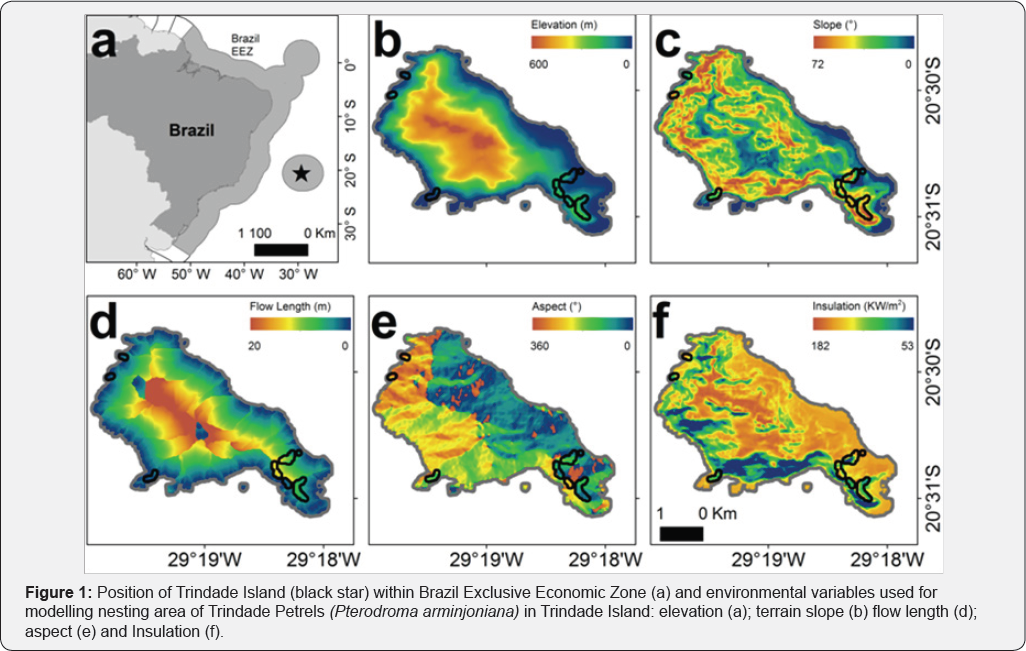
Modelling Approach
Ecological niche modelling and species distribution modelling (nesting habitat modelling in the context of this study) are variants of the same analytical approach. This approach relies on the assumption that the occurrence of the species reflects its niche and capacity to deal with environmental conditions Guisan and Thuiller [3]; Peterson and Soberon [4]. The main critics towards this approach is that it is static, based solely on correlative measures ignoring ecological processes involved in the presence of the species in a given area Pearson et al. [35]; Lozier et al. [36]; Dormann et al. [37]; Guillera Arroita et al. [38]. For instance, one can argue that seabird nesting is more influenced by biological information shared between individuals in social gatherings and at the colonies per se, and the distance and resource availability in the foraging areas surrounding the colonies Kildaw et al. [39]; Waggitt et al. [40], and so on. However, for species nesting in unreachable areas whose demography, habitat selection behaviour and even at-sea behaviour are only recently being studied, such as Trindade Petrel Kruger et al. [41]; Ramos et al. [42]; Leal et al. [43], those processes cannot be incorporated yet in a thorough investigation of nesting distribution. In the meantime, correlative based methods are useful as tools for determining association with environmental conditions, for detecting areas of higher suitability for nesting and providing insights into management and conservation actions Guisan and Thuiller [3].
I fitted the nest occurrence of the species (411 nests, Figure 1) Kruger et al. [15] in response of five topographical-related variables (Figure 1B-1F) using Correlative machine-learning based models and purely correlative models (see below) using 'biomod2' R-package Thuiller et al. [44]. Machine-learning based modeling of " models fits the occurrence of the presence/absence data towards environmental variables with quadratic binomial functions using iterations (such as bootstrap) to select from a multitude of iterations the best models, and "learning" in order to optimize the best solution at each new iteration Bzdok et al. [45]. Artificial Neural Network uses a non-linear learning algorithm to select best solution fitting occurrence to environmental data Lek and Guegan [46]. Random forests iterate regression trees and combines the final results by averaging Prasad et al. [47]; Cutler et al.[48], and Generalized Boosted Model is a variant of the Random Forest model, which uses a selection procedure (crossvalidation) in order to chose the best regression trees to use in the final averaging Ridgeway [49]; Elith et al. [50]. MaxEnt Entropy models selects the iterations by comparing it to a theoretical estimated uniform random distribution, it is, with maximized entropy Merow et al. [51]; Phillips et al. [52]. Generalized Linear Model GLM uses a quadratic binomial equation to fit the occurrence to the environmental data, and Generalized Additive Model is a GLM where the predictor is smoothed by a non-linear smoothing term estimated from data error Hastie and Tibshirani [53]; Liu [54]. Finally, Multiple Adaptive Regression Splines uses basis functions to select splines on distinct intervals of the predictors and fit the response variables to those intervals Prasad et al. [47]; Friedman [55]. Those models have been demonstrated to be the best among a handful models available for modelling species distribution through ecological niche modelling Zhang et al. [24]; Quillfeldt et al. [52]; Kruger et al. [56]. For full models' parameterization use in this study see Table 1. The spatial output of all those models is the estimated probability of occurrence varying from 0 to 1, which in this case can be interpreted as suitability for nesting.
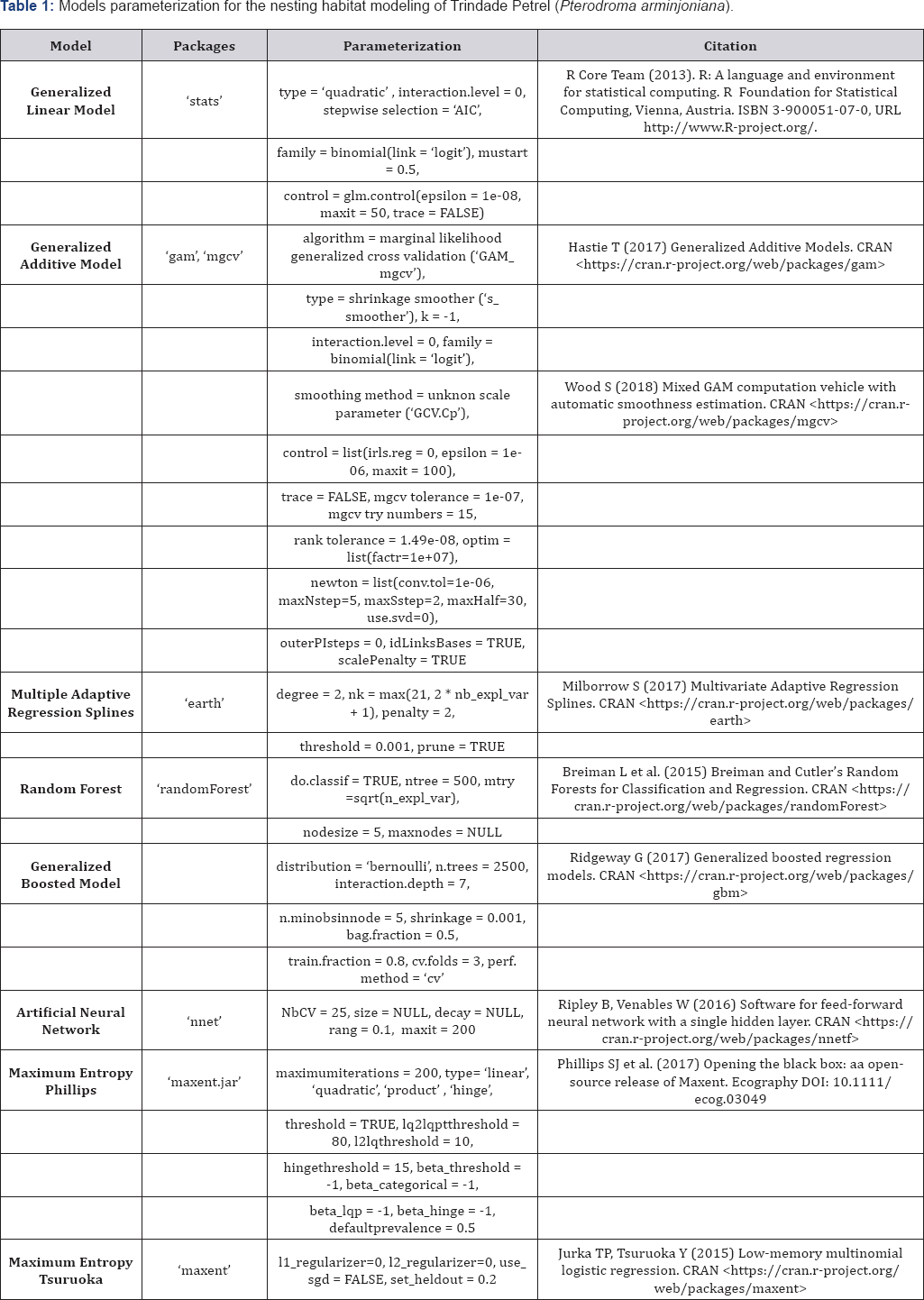
I generated as much pseudo-absences as nest points (411) replicated 20 times Van Der Wal et al. [57]; Barbet Massin et al. [58]
Data was split in 80% for training and 20% for testing in three runs, totalizing 60 replications for each model. I selected the best replications through calculation of accuracy by using the Area Under the ROC Curve AUC and the True Skill Statistics Zhang et al. [24]; Wisz et al. [59]; Marmion et al. [44]; Liu et al. [54]. Despite criticism for the use of those classification-based metrics Allouche et al. [60]; Lobo et al. [61]; Peterson et al. [62], those are still two of the most used and recognizable accuracy metrics in ecological modelling of seabirds Legrand et al. [9]; Oppel et al. [23]; Quillfeldt et al. [52]; Quillfeldt et al. [52]; Pereira et al. [56]. I tested if the more "classification-accurate" repetitions also had a good fit using pseudo-R2 statistics calculated using the 'pscl' R package Jackman et al. [63]. I used the proportion in change of accuracy (AUC and TSS) when the variable was excluded from the model to measure the importance of each variable in the modelling procedure. I used the 5 more accurate repetitions from the 3 best models to calculate area of nesting (by averaging outputs from those models weighted by their accuracy, it is, more accurate models are more important in the final distribution output, Araujo and New 2007) and breeding population size. I estimated population size by a density approach Kruger et al. [15]. The 411 mapped nests were distributed in an area of 37.67 ha. Two studies found that ~40m was the better distance to detect most nests within sub-colonies of Antarctic Petrel Thalassoica antarctica Lorentsen et al. [64] and Puffins Fratercula arctica (Anker-Nilssen and Rostad 1993). Taking in account the error of the GPS (±4m), I created a 50m buffer around each nest, and used the final joint polygon to estimate the mapped area (Figure 2) . Finally, I extrapolated the number of nests from the mapped density over the area of occurrence of nests from the 15 best model repetitions classified in presence or absence using the mean value of probability calculated by Biomod2 as the optimal value to maximize correct classifications.

I entered a satellite picture (from google earth pro) of Trindade Island on a supervised classification procedure using ArcGis in order to classify two types of vegetation: the succession vegetation and the remnant forest-like vegetation (Figure 3). After classification, I converted each grid image into point shapefiles, and modelled vegetation distribution using the same approach used for the Trindade Petrel, but using only the previously best models (Generalized Additive Model, Random Forest and Generalized Boosted Model, see results). I estimated the ensemble distribution of vegetation types from repetitions with AUC and TSS above 0.8 and 0.7, respectively (Engler et al. [65]; Araujo et al. [66])
Topogaphy Versus Vegetation
Posteriorly, I modelled nesting habitat of the Trindade Petrel using the best three topographical variables identified in the previous steps, but this time I entered the distribution of vegetation types into the models. I simulated scenarios where vegetation was increased and projected nesting distribution. I considered four different increased vegetation scenarios: vegetation distribution increased in 25% (T1) and 50% (T2) with no change in forest-like vegetation, and increase in 50% of succession vegetation with 25% (T3) and 50% (T4) increase in forest-like vegetation. I used the same density-based approach in order to calculate population changes for each increased vegetation scenario.
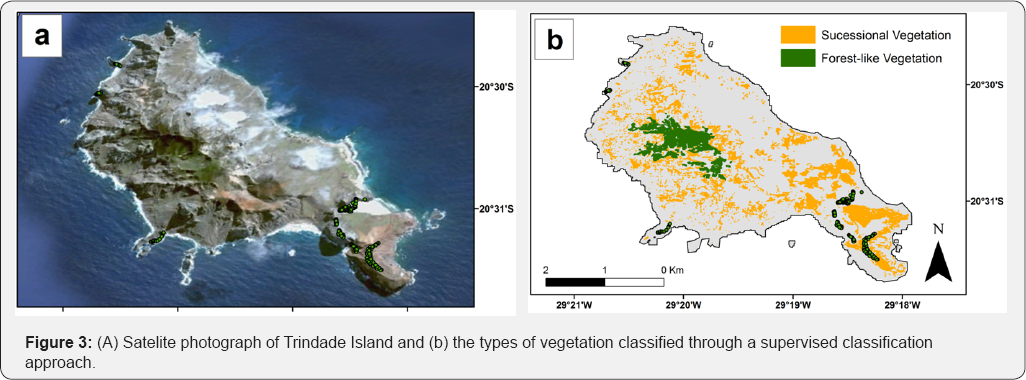
Topogaphy Versus Vegetation
Posteriorly, I modelled nesting habitat of the Trindade Petrel using the best three topographical variables identified in the previous steps, but this time I entered the distribution of vegetation types into the models. I simulated scenarios where vegetation was increased and projected nesting distribution. I considered four different increased vegetation scenarios: vegetation distribution increased in 25% (T1) and 50% (T2) with no change in forest-like vegetation, and increase in 50% of succession vegetation with 25% (T3) and 50% (T4) increase in forest-like vegetation. I used the same density-based approach in order to calculate population changes for each increased vegetation scenario.
Results
Topographical Models Accuracy
All the repetitions presented AUC above 0.7 and almost one third of the replications (32.7%, 157 out of 483 replications) presented TSS below 0.7. The machine-learning based models performed better than the purely correlative models, and correlative models performed better than Maximum Entropy models (Figure 4). The models which resulted in the higher number of highly accurate predictions were Random Forest, Generalized Boosted Model and Generalized Additive Model (Figure 4). The three more accurate models also had good fit and independently of the statistic used, the higher the classification accuracy the higher the fit (Figure 4).
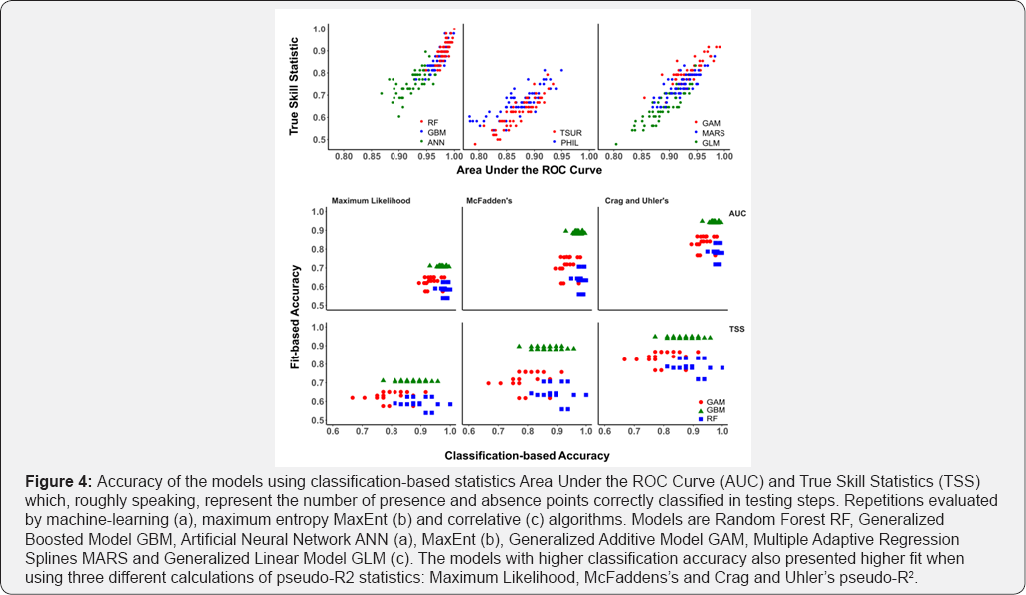
Topographical Nesting Habitat and Colony Distribution
The five best replications from the three more accurate models (RF, GBM and GAM) generated similar response curves for all variables, compared to a less accurate model (Figure 5). Elevation and slope were the two more important variables in the modelling (Figure 5A & 5B), while Flow Length, Aspect and Insulation were of minor importance (<0.3) for most repetitions (Figure 5C- 5E). Trindade Petrel had a higher probability of nesting in elevations between 100 and 250 meters (Figure 5A), in areas with slope above 45° of inclination (Figure 5B), with smaller runoff (Figure 5c) in terrains usually facing northerly direction (Figure 5D) with intermediate sun incidence (Figure 5e). But even those slight differences among models generated predictions with considerable differences. Estimated areas of colony occurrence varied from 0.31 Km2 to 2.16 Km2 (Figure 6). Random forest was the model which predicted in average the smaller area of colony and generalized additive model predicted the larger area, and as consequence, the estimated breeding population size (number of nests or breeding pairs) varied between 884 and 2354 (Table 2), and the mean of all the 15 replications was 1349 ± 623 pairs (Figure 6). Ensemble outputs (mean suitability ± standard deviation and counting the number of models predicting presence) produced similar results and indicated that the sampled colonies were correctly fitted (Figure 7A-7C). Finally, the zones where all the 15 replications predicted nest occurrence are assumed to be the most probable colony areas where the 1349 ± 623 pairs are expected to be distributed (Figure 7D).

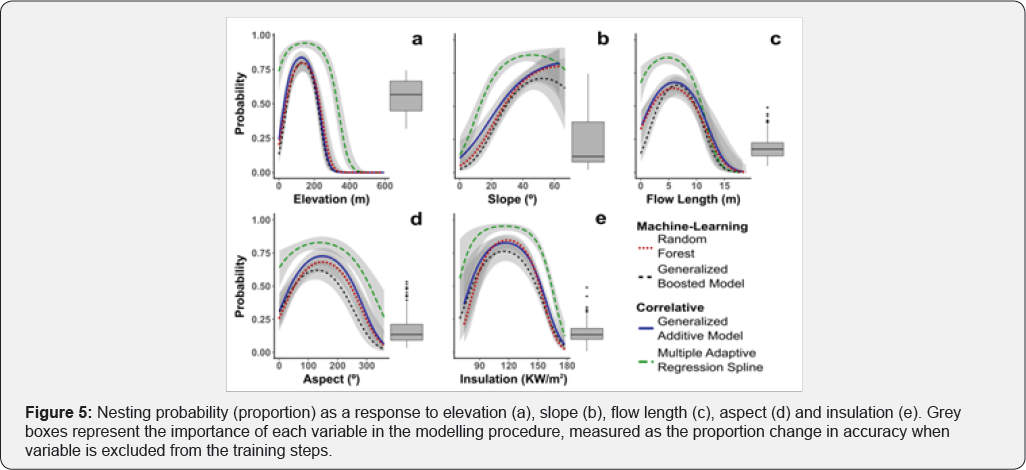
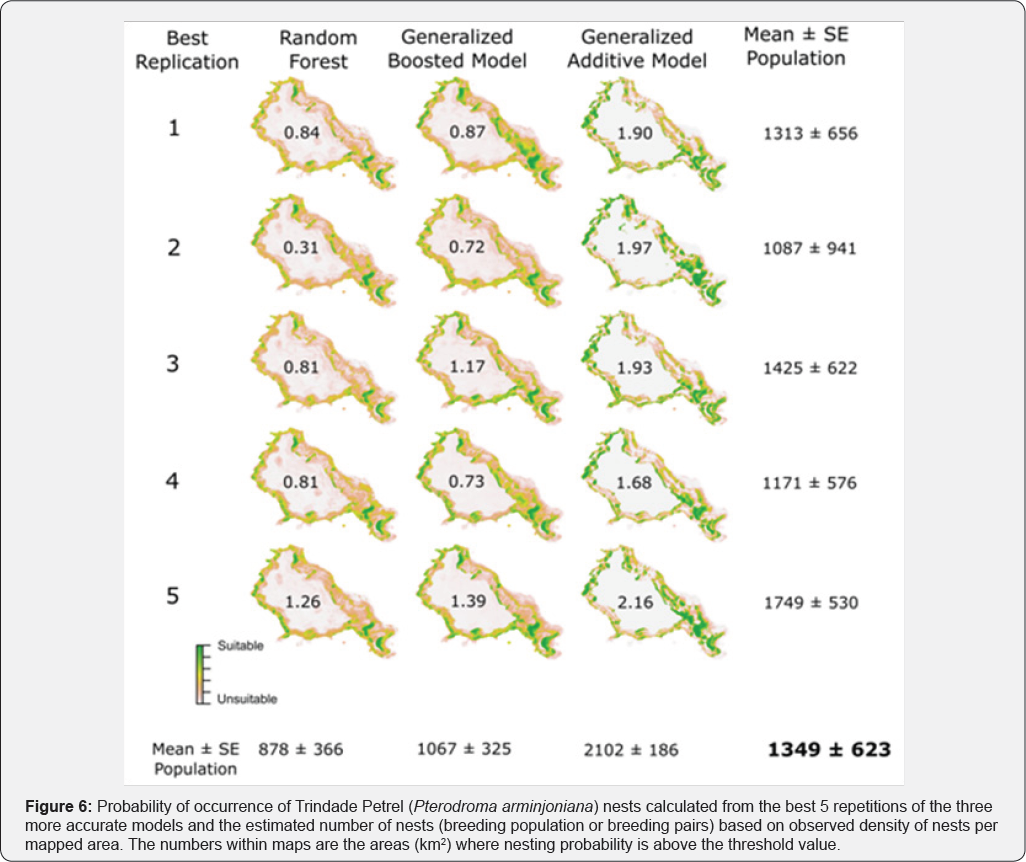

Nesting Habitat and the Distribution of Vegetation
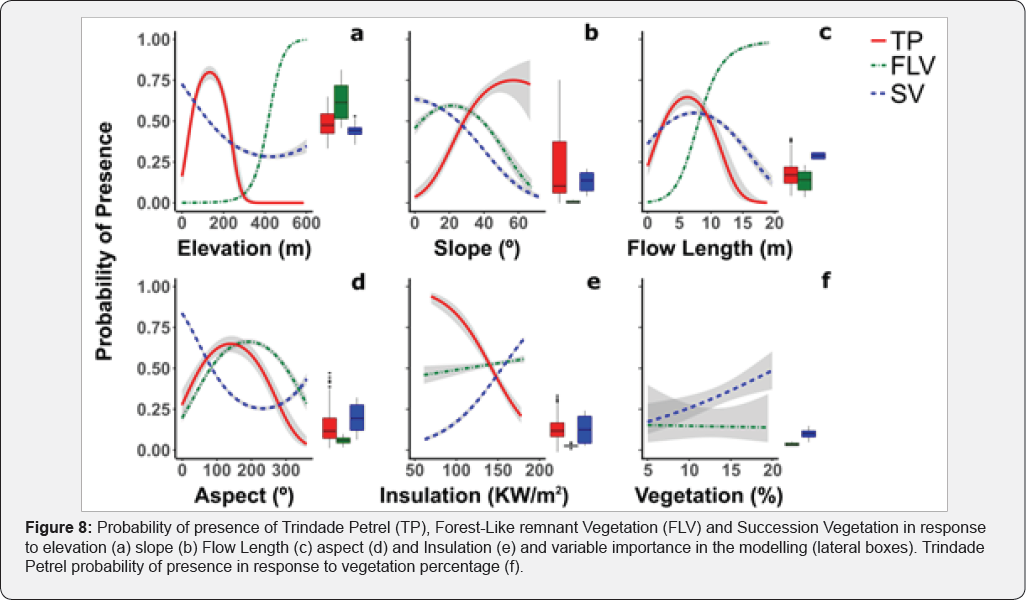
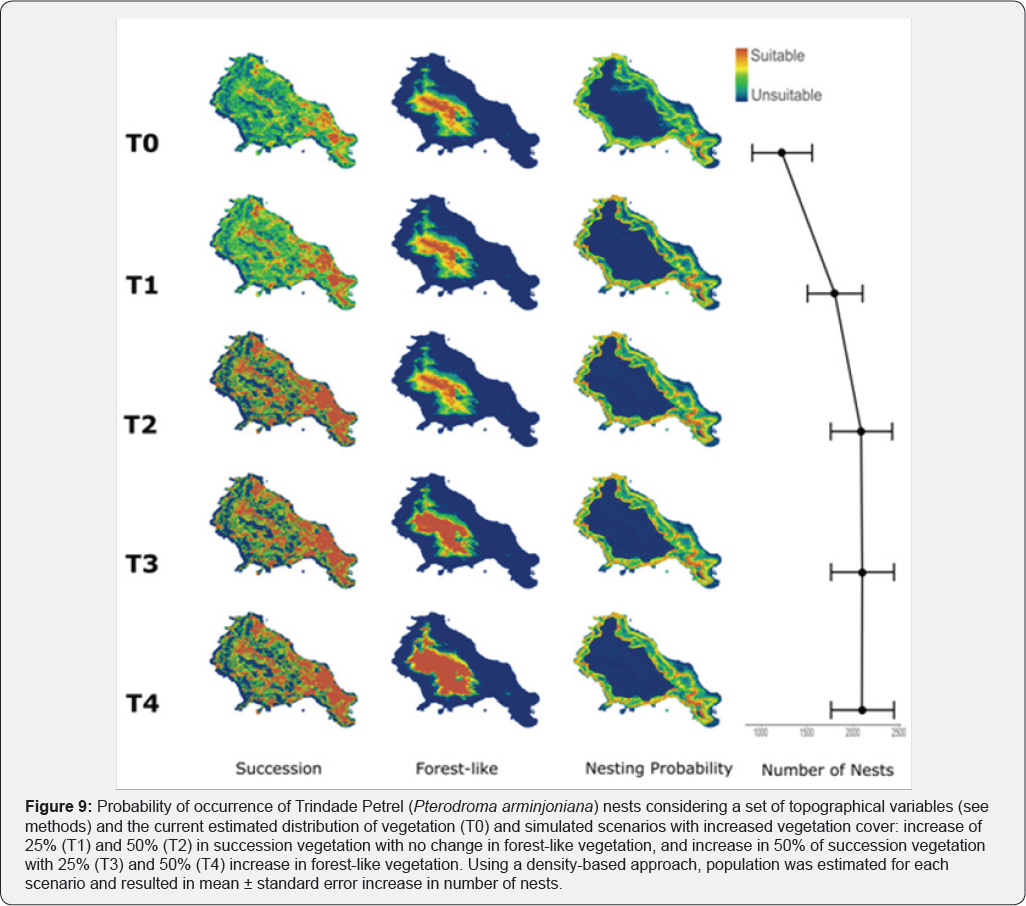
All the repetitions for modelling the forest-like remnant vegetation distribution had AUC>0.9 and TSS>0.8, while only half of repetitions for modelling succession vegetation distribution presented AUC>0.8, while TSS was below 0.6 for all repetitions. Elevation was the variable more important for modelling of both types of vegetation, while the other variables all had importance below 40% (Figure 8). Vegetation types were associated to opposite conditions of Elevation, Flow Length, Aspect and Insulation (Figure 8A-8E). A 100% of repetitions for modelling nesting habitat had AUC>0.9 and 79.2% of repetitions had TSS>0.8. However, contribution of vegetation type to modelling nesting habitat was below 20% for all the repetitions (Figure 8F). The occurrence of nests of Trindade Petrel were non-responsive to the forest-like remnant vegetation and a higher occurrence of succession vegetation (20%) slightly increases the probability of nesting to above 45% (Figure 8F). For this reason, increasing the succession vegetation increased the potential area of nesting and the estimated population almost doubled, but increasing the forest-like remnant vegetation had no effect on the area of nesting, therefore no substantial change in population (Figure 9).
Discussion
The use of different models is a better approach when realizing the modelling of a species distribution based on points of occurrence Qiao et al. [14]; Coetzee et al. [21]; Araujo and New [67] and the results of this study support this findings. Models with similar accuracy may produce considerably different outputs and such fact should be in mind of modellers when designing and applying statistic-based methods Scales et al. [8], Qiao et al. [14], Marmion et al. [44], this study. Models that were accounted to be of higher accuracy in other studies, such as MaxEnt, can perform poorly in different situations Oppel et al. [23]; Friedlaender et al. [68]; Quillfeldt et al. [52]; Kruger et al. [56]. Therefore, the accuracy of the models is context dependent and should always be taken in consideration on distribution modelling studies. Such finding justify the re-evaluation of the study of Kruger et al. [15] which used MaxEnt. MaxENt peformed poorly for this databank when compared to other two machine- learning based (RF and GBM) and one correlative (GAM) model. Despite that differences, the mean estimate of population size in this study is within the absolute values estimated by both Luigi et al. [26] of 1130 pairs and Kruger et al. [15] 1048 pairs. It also highlights the advantages of the ensemble procedure as it allows for estimating uncertainty associated with the models outputs and allows assigning levels of confidence over observed differences Pearson et al. [35]; Meyer et al. [69]; Clark [70].
As stressed out in Kruger et al. [15], Trindade Petrel population numbers before impact of human colonization and settlement are mostly anecdotal, but it is probable that the species was more abundant. Lee [71,72] affirms that a population decline between 1970 and 1990 can be inferred through reductions in sightings at the non-breeding distribution. Considering also the possibility that historical numbers could be as high as 15000 individuals (Birdlife International 2015) raises concern about the status of this population, which probably embrace the majority of species numbers (Birdlife International 2015). It is possible that the current trend of Trindade Petrel nesting in cliffs was selected by the combined effects of goat trampling, feral cats and intense egg predation by introduced crabs Fonseca Neto [25]; Luigi et al. [26]; Alves [27], however the original relation of the birds with nesting habitat, if it was different from nowadays, is not possible to be accessed nor inferred. Trindade Island was once covered by an abundant forest-like tropical vegetation Alves [27]; Soto [28] and restoration of such original condition is slow, but it is underway (Silva and Alves 2011). The effects of a potential restoration of original vegetation conditions on nesting of Trindade Petrel probably would have a positive effect on the population, but with a considerable uncertainty around it (this study). Currently, the forest-like vegetation is only associated with higher elevations, therefore the Petrels did not reproduce not even in the vicinities of the remnant vegetation Kruger et al. [15]; Luigi [26]. It is interesting to note that Trindade Petrel nesting mismatches the habitat of the remnant vegetation for several variables other than elevation. Nesting occurs in steeper slopes in zones of lower flow lengths and at low insulated habitats, while the forest-like vegetation occurrence is limited to slopes 45° steep, high flow length with minor effect of insulation. In a certain manner, Trindade Petrel nesting habitat differentiates from other Pterodroma species, like Cook's Petrel (Pterodroma cookii), Baraus Petrel (P. baraui) and Mottled Petrels (Pterodroma inexpectata) which are associated with denser vegetation at higher elevations Scott et al. [13].
Several tropical Pterodroma species have experienced considerable declines due to introduction of grazing large mammals which severely modified original habitat and restricted breeding colonies towards inaccessible areas Zino et al. [73]; Rayner et al. [74]; Pinet et al. [75]. However, Trindade Petrel seems to differentiate from other Pterodroma Species in its nesting habitat. I envisage that management actions as speeding up habitat restoration (Bellingham et al. 2010) could be beneficial to the species in order to provide new nesting habitats or to help consolidate new breeding grounds in currently unoccupied aeas within Trindade Island. However, as seabird nesting habitat selection has a strong social component Kildaw et al. [39]; Waggitt et al. [40], any attempt to increase Trindade Petrel populations should consider further approaches like the introduction of artificial nests for stimulate recruitment (Sherley et al. [76]; Libois et al. [77]; Sutherland et al. [78] or attraction techniques Parker et a l. [79]. The current threat posed by predation of the terrestrial crab Fonseca Neto [25], Luigi [26]) may also be considered. Relocation to more favourable habitats Bellingham et al. [80]; Jones and Kress [81] where crabs are less dense could also represent a potential action. Future studies also should consider proposing management actions in order to reduce the terrestrial crab density. For all the cases, using an ensemble approach for detecting suitable habitat can be helpful in order to help conservation decisions, for instance, detecting which areas vegetation recover should be implemented more emphatically or where to concentrate population control of crabs. Assuming areas where several models are consistent in indicating the species presence are better suited for species Araujo [67], this study, this approach can reduce the uncertainties regarding the habitat suitability for the species at the selected areas and may potentially increase the success of any conservation action [82-86].
To know more about Juniper Publishers please click on: https://juniperpublishers.com/manuscript-guidelines.php
For more articles in Open Access Journal of Environmental Sciences & Natural Resources please click on: https://juniperpublishers.com/ijesnr/index.php



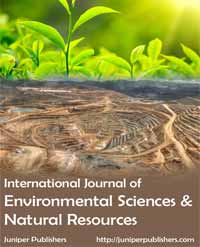
Comments
Post a Comment